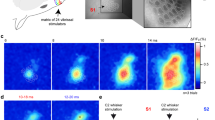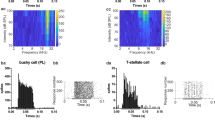Abstract
Anatomical, stimulation and lesion data implicate vibrissa motor cortex in whisker motor control. Work on motor cortex has focused on movement generation, but correlations between vibrissa motor cortex activity and whisking are weak. The exact role of vibrissa motor cortex remains unknown. We recorded vibrissa motor cortex neurons during various forms of vibrissal touch, which were invariably associated with whisker protraction and movement. Free whisking, object palpation and social touch all resulted in decreased cortical activity. To understand this activity decrease, we performed juxtacellular recordings, nanostimulation and in vivo whole-cell recordings. Social touch resulted in decreased spiking activity, decreased cell excitability and membrane hyperpolarization. Activation of vibrissa motor cortex by intracortical microstimulation elicited whisker retraction, as if to abort vibrissal touch. Various vibrissa motor cortex inactivation protocols resulted in contralateral protraction and increased whisker movements. These data collectively point to movement suppression as a prime function of vibrissa motor cortex activity.
This is a preview of subscription content, access via your institution
Access options
Subscribe to this journal
Receive 12 print issues and online access
$209.00 per year
only $17.42 per issue
Buy this article
- Purchase on Springer Link
- Instant access to full article PDF
Prices may be subject to local taxes which are calculated during checkout





Similar content being viewed by others
Change history
17 November 2016
In the version of this article initially published online, the x axes in Figure 1e,g,i were labeled "Time (Hz)"; the correct label is "Time (s)." Also, the P value in Figure 1j was given as 0.00018; the correct value is 0.0018. The errors have been corrected for the print, PDF and HTML versions of this article.
References
Hall, R.D. & Lindholm, E.P. Organization of motor and somatosensory neocortex in the albino rat. Brain Res. 66, 23–38 (1974).
Gioanni, Y. & Lamarche, M. A reappraisal of rat motor cortex organization by intracortical microstimulation. Brain Res. 344, 49–61 (1985).
Haiss, F. & Schwarz, C. Spatial segregation of different modes of movement control in the whisker representation of rat primary motor cortex. J. Neurosci. 25, 1579–1587 (2005).
Tandon, S., Kambi, N. & Jain, N. Overlapping representations of the neck and whiskers in the rat motor cortex revealed by mapping at different anaesthetic depths. Eur. J. Neurosci. 27, 228–237 (2008).
Brecht, M. et al. Organization of rat vibrissa motor cortex and adjacent areas according to cytoarchitectonics, microstimulation, and intracellular stimulation of identified cells. J. Comp. Neurol. 479, 360–373 (2004).
Brecht, M., Schneider, M., Sakmann, B. & Margrie, T.W. Whisker movements evoked by stimulation of single pyramidal cells in rat motor cortex. Nature 427, 704–710 (2004).
Matyas, F. et al. Motor control by sensory cortex. Science 330, 1240–1243 (2010).
Neafsey, E.J. et al. The organization of the rat motor cortex: a microstimulation mapping study. Brain Res. 396, 77–96 (1986).
Welker, W.I. Analysis of sniffing of the albino rat. Behaviour 22, 223–244 (1964).
Kleinfeld, D., Ahissar, E. & Diamond, M.E. Active sensation: insights from the rodent vibrissa sensorimotor system. Curr. Opin. Neurobiol. 16, 435–444 (2006).
Georgopoulos, A.P., Schwartz, A.B. & Kettner, R.E. Neuronal population coding of movement direction. Science 233, 1416–1419 (1986).
Lemon, R. The output map of the primate motor cortex. Trends Neurosci. 11, 501–506 (1988).
Carvell, G.E., Miller, S.A. & Simons, D.J. The relationship of vibrissal motor cortex unit activity to whisking in the awake rat. Somatosens. Mot. Res. 13, 115–127 (1996).
Hill, D.N., Curtis, J.C., Moore, J.D. & Kleinfeld, D. Primary motor cortex reports efferent control of vibrissa motion on multiple timescales. Neuron 72, 344–356 (2011).
Friedman, W.A., Zeigler, H.P. & Keller, A. Vibrissae motor cortex unit activity during whisking. J. Neurophysiol. 107, 551–563 (2012).
Gerdjikov, T.V., Haiss, F., Rodriguez-Sierra, O.E. & Schwarz, C. Rhythmic whisking area (RW) in rat primary motor cortex: an internal monitor of movement-related signals? J. Neurosci. 33, 14193–14204 (2013).
Asanuma, H. Recent developments in the study of the columnar arrangement of neurons within the motor cortex. Physiol. Rev. 55, 143–156 (1975).
Penfield, W. & Rasmussen, T. The Cerebral Cortex of Man (Macmillan, 1952).
Graziano, M.S., Taylor, C.S., Moore, T. & Cooke, D.F. The cortical control of movement revisited. Neuron 36, 349–362 (2002).
Bobrov, E., Wolfe, J., Rao, R.P. & Brecht, M. The representation of social facial touch in rat barrel cortex. Curr. Biol. 24, 109–115 (2014).
Wolfe, J., Mende, C. & Brecht, M. Social facial touch in rats. Behav. Neurosci. 125, 900–910 (2011).
Lenschow, C. & Brecht, M. Barrel cortex membrane potential dynamics in social touch. Neuron 85, 718–725 (2015).
Lee, E. et al. Enhanced neuronal activity in the medial prefrontal cortex during social approach behavior. J. Neurosci. 36, 6926–6936 (2016).
Schiemann, J. et al. Cellular mechanisms underlying behavioral state-dependent bidirectional modulation of motor cortex output. Cell Rep. 11, 1319–1330 (2015).
Moore, J.D. et al. Hierarchy of orofacial rhythms revealed through whisking and breathing. Nature 497, 205–210 (2013).
Deschênes, M. et al. Inhibition, not excitation, drives rhythmic whisking. Neuron 90, 374–387 (2016).
Dörfl, J. The musculature of the mystacial vibrissae of the white mouse. J. Anat. 135, 147–154 (1982).
Haidarliu, S., Simony, E., Golomb, D. & Ahissar, E. Muscle architecture in the mystacial pad of the rat. Anat. Rec. (Hoboken) 293, 1192–1206 (2010).
Herfst, L.J. & Brecht, M. Whisker movements evoked by stimulation of single motor neurons in the facial nucleus of the rat. J. Neurophysiol. 99, 2821–2832 (2008).
Berg, R.W. & Kleinfeld, D. Vibrissa movement elicited by rhythmic electrical microstimulation to motor cortex in the aroused rat mimics exploratory whisking. J. Neurophysiol. 90, 2950–2963 (2003).
Huber, D. et al. Multiple dynamic representations in the motor cortex during sensorimotor learning. Nature 484, 473–478 (2012).
Semba, K. & Komisaruk, B.R. Neural substrates of two different rhythmical vibrissal movements in the rat. Neuroscience 12, 761–774 (1984).
Gao, P., Hattox, A.M., Jones, L.M., Keller, A. & Zeigler, H.P. Whisker motor cortex ablation and whisker movement patterns. Somatosens. Mot. Res. 20, 191–198 (2003).
Kolb, B. Functions of the frontal cortex of the rat: a comparative review. Brain Res. 320, 65–98 (1984).
Kawai, R. et al. Motor cortex is required for learning but not for executing a motor skill. Neuron 86, 800–812 (2015).
Stoltz, S., Humm, J.L. & Schallert, T. Cortical injury impairs contralateral forelimb immobility during swimming: a simple test for loss of inhibitory motor control. Behav. Brain Res. 106, 127–132 (1999).
Zagha, E., Ge, X. & McCormick, D.A. Competing neural ensembles in motor cortex gate goal-directed motor output. Neuron 88, 565–577 (2015).
Mikuni, N. et al. Evidence for a wide distribution of negative motor areas in the perirolandic cortex. Clin. Neurophysiol. 117, 33–40 (2006).
Filevich, E., Kühn, S. & Haggard, P. Negative motor phenomena in cortical stimulation: implications for inhibitory control of human action. Cortex 48, 1251–1261 (2012).
Kuypers, H.G.J.M. A new look at the organization of the motor system. Prog. Brain Res. 57, 381–403 (1982).
Grinevich, V., Brecht, M. & Osten, P. Monosynaptic pathway from rat vibrissa motor cortex to facial motor neurons revealed by lentivirus-based axonal tracing. J. Neurosci. 25, 8250–8258 (2005).
Sreenivasan, V., Karmakar, K., Rijli, F.M. & Petersen, C.C.H. Parallel pathways from motor and somatosensory cortex for controlling whisker movements in mice. Eur. J. Neurosci. 41, 354–367 (2015).
Cheney, P.D. & Fetz, E.E. Functional classes of primate corticomotoneuronal cells and their relation to active force. J. Neurophysiol. 44, 773–791 (1980).
Davidson, A.G., Chan, V., O'Dell, R. & Schieber, M.H. Rapid changes in throughput from single motor cortex neurons to muscle activity. Science 318, 1934–1937 (2007).
Bonini, L., Maranesi, M., Livi, A., Fogassi, L. & Rizzolatti, G. Ventral premotor neurons encoding representations of action during self and others' inaction. Curr. Biol. 24, 1611–1614 (2014).
Dushanova, J. & Donoghue, J. Neurons in primary motor cortex engaged during action observation. Eur. J. Neurosci. 31, 386–398 (2010).
Vigneswaran, G., Philipp, R., Lemon, R.N. & Kraskov, A. M1 corticospinal mirror neurons and their role in movement suppression during action observation. Curr. Biol. 23, 236–243 (2013).
Kraskov, A. et al. Corticospinal mirror neurons. Phil. Trans. R. Soc. Lond. B 369, 20130174 (2014).
Schieber, M.H. Mirror neurons: reflecting on the motor cortex and spinal cord. Curr. Biol. 23, R151–R152 (2013).
Purves, D. et al. Neuroscience (Sinauer Associates, Sunderland, MA, 2004).
Rao, R.P., Mielke, F., Bobrov, E. & Brecht, M. Vocalization-whisking coordination and multisensory integration of social signals in rat auditory cortex. eLife 3, 1–20 (2014).
Stockwell, R.G., Mansinha, L. & Lowe, R.P. Localization of the complex spectrum: the S transform. IEEE Trans. Signal Process. 44, 998–1001 (1996).
Schmitzer-Torbert, N., Jackson, J., Henze, D., Harris, K. & Redish, A.D. Quantitative measures of cluster quality for use in extracellular recordings. Neuroscience 131, 1–11 (2005).
Barthó, P. et al. Characterization of neocortical principal cells and interneurons by network interactions and extracellular features. J. Neurophysiol. 92, 600–608 (2004).
Vigneswaran, G., Kraskov, A. & Lemon, R.N. Large identified pyramidal cells in macaque motor and premotor cortex exhibit “thin spikes”: implications for cell type classification. J. Neurosci. 31, 14235–14242 (2011).
Houweling, A.R., Doron, G., Voigt, B.C., Herfst, L.J. & Brecht, M. Nanostimulation: manipulation of single neuron activity by juxtacellular current injection. J. Neurophysiol. 103, 1696–1704 (2010).
Pinault, D. A novel single-cell staining procedure performed in vivo under electrophysiological control: morpho-functional features of juxtacellularly labeled thalamic cells and other central neurons with biocytin or Neurobiotin. J. Neurosci. Methods 65, 113–136 (1996).
Tang, Q., Brecht, M. & Burgalossi, A. Juxtacellular recording and morphological identification of single neurons in freely moving rats. Nat. Protoc. 9, 2369–2381 (2014).
Sürmeli, G. et al. Molecularly defined circuitry reveals input-output segregation in deep layers of the medial entorhinal cortex. Neuron 88, 1040–1053 (2015).
Clack, N.G. et al. Automated tracking of whiskers in videos of head fixed rodents. PLoS Comput. Biol. 8, e1002591 (2012).
MacDonald, C.J., Lepage, K.Q., Eden, U.T. & Eichenbaum, H. Hippocampal “time cells” bridge the gap in memory for discontiguous events. Neuron 71, 737–749 (2011).
Tehovnik, E.J., Tolias, A.S., Sultan, F., Slocum, W.M. & Logothetis, N.K. Direct and indirect activation of cortical neurons by electrical microstimulation. J. Neurophysiol. 96, 512–521 (2006).
Aarts, E., Verhage, M., Veenvliet, J.V., Dolan, C.V. & van der Sluis, S. A solution to dependency: using multilevel analysis to accommodate nested data. Nat. Neurosci. 17, 491–496 (2014).
Tehovnik, E.J. & Sommer, M.A. Effective spread and timecourse of neural inactivation caused by lidocaine injection in monkey cerebral cortex. J. Neurosci. Methods 74, 17–26 (1997).
Acknowledgements
We thank B. Geue, U. Schneeweiß and J. Diederichs for technical assistance and V. Bahr and F. Mielke for assistance with programming. We thank M. Rüsseler for assistance with video tracking and R.P. Rao and E. Bobrov for sharing tracked whisker traces of behaving rats. We thank S. Helgheim Tawfiq for behavior drawings. We thank A. Neukirchner, E. Chorev, S. Ray, P. Bennett and A. Clemens for comments on the manuscript. This work was supported by Humboldt-Universität zu Berlin, the Bernstein Center for Computational Neuroscience Berlin, the German Federal Ministry of Education and Research (BMBF, Förderkennzeichen 01GQ1001A, M.B.) and NeuroCure. M.B. was a recipient of a European Research Council grant and the Gottfried Wilhelm Leibniz Prize.
Author information
Authors and Affiliations
Contributions
C.L.E., G.D. and M.B. designed the study. C.L.E. performed tetrode experiments. C.L.E. and G.D. performed juxtacellular experiments. G.D. and C.L. performed whole-cell recordings. C.L.E. and G.D. performed microstimulation and blockade experiments. C.L.E. analyzed the data and performed statistical modeling. C.L.E. and M.B. wrote the first version of the manuscript. All authors assisted with analyzing data and contributed to writing the manuscript.
Corresponding author
Ethics declarations
Competing interests
The authors declare no competing financial interests.
Integrated supplementary information
Supplementary Figure 1 Whisker tracking procedure and additional modeling
(a)Example high-speed (250 frames/s) video frame showing whiskers of a head-fixed rat during a juxtacellular recording experiment. The pivot point (red dot) and the whisker tracking ROI (green dots) are manually clicked for tracking each video.
(b)Example traces demonstrating the tracking procedure. We rotated adjacent frames around the pivot point shown in (a) to maximize the correlation between the frames within the whisking ROI (‘Pearson’s ρ‘, top trace) and estimated the mean change in angles between adjacent frames (‘ΔAngle’, middle traces). Datapoints with sudden spikes in the correlation between frames due to video artifacts were removed from the traces (example marked by black arrow). To estimate the whisking angle, we linearly interpolated, numerically integrated and band-pass filtered the change in angle between frames (‘Angle’, bottom trace). Grey bar indicates a nose-to-nose touch.
(c)Top: Distribution of βAmpl for all cells is not different from zero (P = 0.204, Wilcoxon signed-rank test, also shown in Fig 3c). Bottom: When we plot only significant cells (assessed by a likelihood ratio test), the pattern is mixed: 10 cells are suppressed (red bars) and 6 cells are activated (blue bars). As a population, they are not different from zero (P = 0.098, Wilcoxon signed-rank test), but we note that the suppressed cells tend to be more strongly modulated that the activated cells: (median |βAmpl|= 0.221/0.128 for suppressed/activated cells, P = 0.00025, Mann-Whitney U-test).
(d)Soma of example juxtacellularly labeled Ctip2-negative cell.
(e)Example recorded data and fitted model from the neuron shown in (d). The top traces show the occurrence of nose-no-nose touches (grey bars), the juxtacellular recording trace with spikes (high-pass filtered at 300 Hz, top trace) and the whisker angle and whisking amplitude (tracked by high-speed videography). Below we show the estimate of the instantaneous firing rate of the best fitted model (green line, smoothed with a Gaussian with σ = 75 ms) plotted on top of an estimate of the observed firing rate (grey area, calculated by convolving the spike train with a Gaussian with σ = 75 ms, clipped at 10 Hz for plotting). This cell was suppressed by nose touch, whisker protraction and by increased whisking amplitude (maximum likelihood estimates: β0 = 0.03, βNose = −0.70, βAngle = −0.30 (°)-1, βAmpl = −0.38 (°)-1)
(f)Fitted betas, when we run the model shown in Fig 3 on stepwise orthogonalized data. In this model, β’Nose measures how the spike rate depends on nose touch, β’Angle measures how the spike rate depends on ‘the variation in whisker angle, which is orthogonal to variations in nose touch’, and β’Ampl measures how the spike rate depends on ‘the variation in whisking amplitude, which is orthogonal to variations in nose touch and variations in whisker angle’. Bars indicate median β, error bars indicate 95% confidence intervals of the median.
Supplementary Figure 2 Unilateral microstimulation of vibrissa motor cortex shortens social facial touch episodes
(a)Cumulative histograms of the duration of social facial interactions (from first to last whisker-to-whisker touch) on days with VMC microstimulation during interactions (red lines) and days with sham stimulation during interactions (black lines) for one example rat.
(b)Interactions are shorter with VMC microstimulation than during sham stimulation (N = 4 rats, dots indicate median interaction duration, lines indicate slope (with rat-specific intercept) from LME model, colors indicate rats).
Supplementary Figure 3 Unilateral blockade of vibrissa motor cortex (by AMPA & NMDA antagonists) increases contralateral whisker movement and protraction
(a)Example image of anaesthetized rat after unilateral VMC blockade (right hemisphere) by superfusion of APV (an NMDA antagonist) and NBQX (an AMPA antagonist).
(b)Example ipsilateral (blue) and contralateral (red) whisking traces of whisker micromovements, which escape light anaesthesia (Whisker arc 1). The contralateral whiskers are more protracted (~27° vs. ~32°) and the contralateral micromovements have a larger amplitude.
(c)After VMC blockade, the whisker set point is higher contralaterally (red markers) than ipsilaterally (blue markers) to the blocked hemisphere (N = 3 rats).
(d)After VMC blockade, the whisking power is much higher (~5 fold) in the contralateral whiskers than in the ipsilateral whiskers (Markers indicate ratio of contralateral to ipsilateral whisker power).
Supplementary Figure 4 Unilateral blockade of vibrissa motor cortex (by muscimol injection) increases contralateral whisker movement and protraction.
(a)Top: Example image of lightly anaesthetized mouse after unilateral VMC blockade (left hemisphere) by muscimol injection, showing protraction of contralateral whiskers. Bottom: Example whisking pattern from the same mouse showing large whisker movements contralaterally, and smaller whisker movements ipsilaterally.
(b)After VMC blockade, the whisker set point is higher contralaterally (red markers) than ipsilaterally (blue markers) to the blocked hemisphere (N = 4 mice). Round markers indicate that only deep VMC was blocked, square markers indicate that both deep and superficial VMC was blocked.
(c)After VMC blockade, the whisking power is much higher (~8 fold) in the contralateral whiskers than in the ipsilateral whiskers (Markers indicate ratio of contralateral to ipsilateral whisker power). Round markers indicate that only deep VMC was blocked, square markers indicate that both deep and superficial VMC was blocked.
(d)Example ipsilateral (blue) and contralateral (red) whisking traces of whisker micromovements which escape light anaesthesia (Whisker arc 1) in another mouse, showing the whisking patterns at a longer time scale.
Supplementary information
Supplementary Text and Figures
Supplementary Figures 1–4 (PDF 888 kb)
Rights and permissions
About this article
Cite this article
Ebbesen, C., Doron, G., Lenschow, C. et al. Vibrissa motor cortex activity suppresses contralateral whisking behavior. Nat Neurosci 20, 82–89 (2017). https://doi.org/10.1038/nn.4437
Received:
Accepted:
Published:
Issue Date:
DOI: https://doi.org/10.1038/nn.4437
This article is cited by
-
Atavistic and vestigial anatomical structures in the head, neck, and spine: an overview
Anatomical Science International (2023)
-
Highly structured, partner-sex- and subject-sex-dependent cortical responses during social facial touch
Nature Communications (2019)
-
Beyond cognitive myopia: a patchwork approach to the concept of neural function
Synthese (2018)
-
Reorganization of corticospinal output during motor learning
Nature Neuroscience (2017)
-
Motor cortex — to act or not to act?
Nature Reviews Neuroscience (2017)



